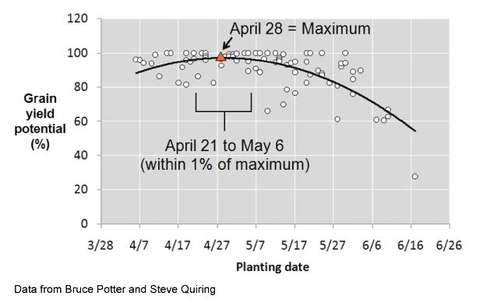Quick facts
Southern Minnesota dairy producers can get the greatest return from their corn silage by:
-
Planting between April 21 and May 6.
-
Having a final stand of 33,500 to 35,500 plants per acre.
-
Using row widths narrower than 30 inches.
With narrow profit margins, it’s critical for dairy producers to re-evaluate agronomic practices such as planting date, plant population and row width for corn silage production.
When to plant for corn silage
From 1997 to 2002, the University of Wisconsin conducted corn silage planting date trials near Lancaster, WI, which is at a similar latitude as Rochester, MN. Averaged across years, silage quality (milk per ton) was within 1 percent of the maximum with planting dates between April 15 and May 17.
However, milk per acre, a function of both milk per ton and silage dry matter yield, was within 1 percent of the maximum in these trials with planting dates between April 21 and May 6.
The Wisconsin results support corn grain research conducted by the University of Minnesota from 1988 to 2003 in Lamberton.
In these trials, an April 28 planting date maximized corn grain yield. On average, planting between April 21 and May 6 produced grain yields within 1 percent of the maximum (Figure 1). For corn silage producers in central Minnesota, optimum planting dates will likely be about four days later.
Although corn silage responds to early planting just like corn grain, the advantage to early planting will be negated if growers plant when soils are too wet. This can result in compacted soil around the seed and seed furrows that open up if dry conditions follow planting.
Optimal plant population
Another important agronomic factor is plant population, especially with high seed costs. In general, silage dry matter yield increases with increased plant population, but dry matter yield increases are slowed when final population rises above 35,000 plants per acre.
Milk per ton, however, decreases at a constant rate as plant population increases. Research conducted by the University of Wisconsin indicates that the economically optimum final population for corn silage is about 1,500 plants per acre higher than that for corn grain.
Research conducted by the University of Minnesota in Lamberton and Waseca between 2004 and 2008 indicates that the economic optimum final population for corn grain is between 32,000 and 34,000 plants per acre, depending on the cost of seed and price of grain.
Thus, a final population between 33,500 and 35,500 plants per acre would be sufficient for optimizing milk per acre from corn silage in Minnesota. Seeding rates will need to be higher, however, to account for less-than-perfect emergence.
Final populations above 35,500 plants per acre will likely result in less milk per acre from corn silage, since forage quality decreases with increasing plant population.
How row width affects silage yield
Row width is another factor to consider, especially for producers that can harvest corn silage planted in rows narrower than 30 inches.
From 1997 to 1999, researchers conducted row width trials for corn silage at 12 sites in south-central Wisconsin, at latitudes similar to Rochester. Trials compared the standard row width of 30 inches to 15- or 20-inch rows, depending upon location.
Findings include:
-
On average, corn silage yield (adjusted to 65 percent moisture) was 7 percent greater with narrow rows.
-
Forage quality was not affected by row width.
-
Optimum plant population was similar for both 30-inch and narrow rows.
-
There was no advantage to final populations above 35,000 plants per acre.
At least 30 other row width comparisons conducted by universities in New York and Pennsylvania found similar results.
View findings and guidance on narrow-row corn planting in Minnesota
Key takeaways
Southern Minnesota dairy producers can get the greatest return from their corn silage when they:
-
Plant between April 21 and May 6.
-
Have a final stand of 33,500 to 35,500 plants per acre.
-
Use row widths narrower than 30 inches, if possible. Equipment costs, however, should be taken into account when deciding whether to plant corn in narrow rows.
-
Minimize soil compaction during silage harvest and manure application.
-
Rotate corn with other crops when possible.
Reviewed in 2021


